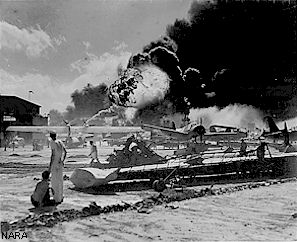
Nov 28 - Dec 6, 1941
Nov 28, 1941
Dec 7, 1941
Dec 8, 1941
Dec 10, 1941
Dec 23, 1941
Dec 7, 1941
History:
Prewar -
1941 -
1942 -
1943 -
1944 -
1945 -
Postwar
The Ship -
All Hands -
Decorations -
Remembrance
 |
| 1941 Chronology |
|---|
| Delivers Marine pilots and planes to Wake Island Nov 28 - Dec 6, 1941 |
| Battle Order Number One Issued Nov 28, 1941 |
| Pearl Harbor Dec 7, 1941 |
| U.S. Declares War Dec 8, 1941 |
| Anti-Submarine Action Dec 10, 1941 |
| Wake Island Falls Dec 23, 1941 |
| Related Links |
| Enterprise Air Group Action Reports Dec 7, 1941 |
While the events that led up to the outbreak of general World War in 1941 are well understood, the motivations for those events are not always agreed upon, even today, over sixty years later.
By December 1941, Axis armies controlled vast areas in and around Europe: from Italy, Spain and North Africa in the south, east nearly to Moscow, north to the Baltic and west to the Atlantic and North Sea. England, already "stripped to the bone" battling German U-boats and bombers, increasingly depended on American shipping and support for her very survival.
In Asia, for decades tension had grown between the European colonial powers - England, Holland and France - the United States, and Japan: the western powers insisting on the right of unfettered access to China's markets, Japan determined to replace Western colonization with her own brand of "Asia for Asians", and the United States as committed to keeping China free and open, as to not propping up the European colonies.
By 1941, the Allied powers were in general agreement that the first priority must be defeating Germany. American war plans reflected the shift in emphasis from defending American and European possessions in the Pacific, to controlling shipping on the Atlantic and preparing for an invasion of Europe itself. Meanwhile, increasing diplomatic and economic pressure was applied to Japan, aimed at forcing her withdrawal from China, where her armies had been involved in a long series of "incidents" since 1931. Japan, however, would not budge. As the year wore on, President Roosevelt and his diplomats, resigned to inevitable armed conflict with Japan, now simply negotiated for time, estimating that by mid-1942 enough forces could be stationed in the Far East to deter Japan from making a grab for the resource-rich Dutch East Indies and Malaysia.
As part of this build-up, Enterprise shuttled Army Air Force P-39s and P-40s, as well as Navy planes, from West Coast ports to Pearl Harbor, and to outlying detachments on Wake and Guam further west. She departed on her last mission of this sort on November 28 - two days after Japan's Pearl Harbor strike force sailed from Japan - carrying Marine pilots and their planes to Wake Island, flying them off on December 2 before turning east to return to Pearl. Forced to slow by a massive weather system which also sheltered the Japanese Combined Fleet advancing on Oahu, Enterprise missed her expected return date to Pearl Harbor: December 6. Instead, she was 150 miles west when the first Japanese bombs began to fall December 7. Her first notice that war had begun came from one of her own pilots, Ensign Manuel Gonzales, of Scouting Six, flying in to Ford Island Naval Air Station that Sunday morning:
"Please don't shoot! Don't shoot! This is an American plane."
Moments later, he was heard ordering his aircrewman Leonard J. Kozelek to bail out: neither man was ever heard from again.
 Scene at Ford Island Naval Air Station, in Pearl Harbor, December 7, 1941. |
Immediately after the attack, Enterprise was ordered to seek out and attack the Japanese fleet. Faulty intelligence and bad guesses led to her to search the waters southwest of Hawaii, where she found only more American ships. It is just as well, though, as it's unlikely Enterprise alone would have been an even match for the six Japanese fleet carriers now escaping west after the devastating morning raids.
At dusk the following day, Enterprise and her Task Force, low on fuel, crept into Pearl Harbor. Angry and frightened voices called out to her: "You'd better get the hell out of here or the Japs will nail you too." "Where in hell were you?" Working in the dark, in shadows cast by the still-burning Arizona, Enterprise refueled while her men hauled on board provisions brought to the ship by lighters. By 0600 the next morning, she had cleared the harbor channel and returned to the vast Pacific, with room to maneuver, room to run.
It was 9 December 1941, and Enterprise was at war.
Image Library -
Action Reports and Logs -
News Stories
Message Boards -
Bookstore -
Enterprise CV-6 Association
Copyright © 1998-2003 Joel Shepherd ([email protected])
Sources and Credits